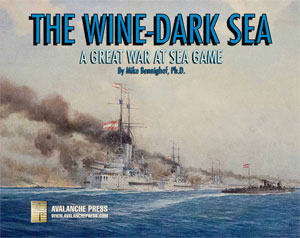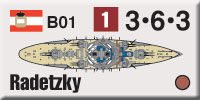| The Wine-Dark Sea:
History & Scenarios, Part Two
By Mike Bennighof, Ph.D.
November 2023
 At the age of 12, I set out to design and write a variant for Avalon Hill’s ancient Jutland game, with a hand-drawn map of the Adriatic Sea and hand-drawn pieces for the Austro-Hungarian and Italian fleets. Well, part of their fleets - it was the pre-internet era, and research was pretty tough when you were limited to your junior high school’s library (which did have this big picture book of World War One battleships). Since computer games were limited to Pong, I couldn’t borrow the order of battle there, like all the true professionals do. At the age of 12, I set out to design and write a variant for Avalon Hill’s ancient Jutland game, with a hand-drawn map of the Adriatic Sea and hand-drawn pieces for the Austro-Hungarian and Italian fleets. Well, part of their fleets - it was the pre-internet era, and research was pretty tough when you were limited to your junior high school’s library (which did have this big picture book of World War One battleships). Since computer games were limited to Pong, I couldn’t borrow the order of battle there, like all the true professionals do.
Over the decades that followed, I would learn a lot more about the Imperial and Royal Navy, and with Great War at Sea: The Wine-Dark Sea, I’ve had another chance to design a game about the campaign on the Adriatic - this time with a little more research behind it.
The Wine-Dark Sea covers the entire Mediterranean theater of World War One, but it’s really a package of three games sharing a map and many of their pieces. Three campaigns dominate the game and take up most of its story: the flight of the battle cruiser Goeben in August 1914, the operations of Goeben on the Black Sea throughout the war, and the Austro-Hungarian Navy in the Adriatic Sea.
The Adriatic campaign was both more difficult and easier to design than the others. The Imperial and Royal Navy hand intended to fight a war in the central Mediterranean, operating from Italian bases as part of the Triple Alliance. When Italy refused to enter the war as an Austrian ally, the fleet command had to quickly re-orient its priorities - unlike the Army, whose leaders had never trusted the Italians, the Navy fully believed it would fight alongside Italy.

The Navy now operated under a very clear directive: to prevent the Allies, in particular the Italians, from outflanking the Alpine front with an attack on the Austrian coastline. And in that mission, it succeeded very well; the fleet was never intended to break out into the central Mediterranean and raise havoc along the Allied shipping routes.
Given the scarcity of resources allocated to the Empire’s three regular armies, and total failure to build a second-line reserve, then as now one could certainly question the wisdom of building dreadnought battleships for such a task. But that’s not the task they were expected to fulfill; certainly some combination of minefields, torpedo boats and submarines could have kept the Italian fleet away from Trieste, Istria and the seaward flank of the land forces at the northern end of the Adriatic. But the naval command was not satisfied with a coast-defense orientation.
As often happens, events veered far from expectations. Had the land forces fielded the four to six more divisions that a re-allocation of the naval budget and manpower might have provided, chief of the general staff Franz Conrad von Hötzendorf would have flung them mindlessly into the slaughterhouse as he did the rest of the pre-war armies. And the dreadnoughts, or more accurately the idea of the dreadnoughts, would keep the Adriatic clear of enemy forces during the war’s later years and thereby allow German (and some Austrian) submarines to use Austria’s bases to engage in commerce warfare in the Mediterranean.
We cover the war the Austrian Navy (and Italian Navy, for that matter) expected to fight, with a set of scenarios based on the Triple Alliance War Plan. We go into even greater depth in our Secret Treaties expansion book. But that’s the not war that happened, even if it is a lot more interesting from the wargame perspective.

The Austrian dreadnoughts at anchor, their usual wartime position.
In the actual war, the Austrians made three major fleet sorties (in August 1914 to support Goeben; in May 1915 to welcome Italy to the war, and in June 1918 to attack the Otranto Barrage, an anti-submarine barrier across the mouth of the Adriatic Sea). The Allies made one attempt to enter the sea with a fleet, when the French penetrated the lower Adriatic in the war’s early days. Cruiser operations were more common, and those by even lighter forces.
That’s not really enough to support a good campaign narrative, just four operations over four years. The unexpected situation led to a flood of plans and proposals on both sides of the Adriatic, and those give us the means to tell a fine story. The sea’s just not very big to begin with, and the routes within it are so obvious that detection is almost guaranteed. When the fleets go to sea, they’re going to fight.
 The Austrians start with three dreadnoughts, picking up a fourth in the war’s second year, and three useful semi-dreadnoughts. The rest of the fleet is made up of undersized ships with undersized guns, boasting underpowered engines. While the Austrians planned to deploy these ships to Sicily as part of the Triple Alliance war plan, they had no place in modern naval warfare. The Austrians start with three dreadnoughts, picking up a fourth in the war’s second year, and three useful semi-dreadnoughts. The rest of the fleet is made up of undersized ships with undersized guns, boasting underpowered engines. While the Austrians planned to deploy these ships to Sicily as part of the Triple Alliance war plan, they had no place in modern naval warfare.
They face two separate enemy fleets blockading the entrance to the Adriatic, with the French initially manning the blockade from the occupied Greek island of Corfu, and later the Italians from Brindisi (their forward base) and Taranto (their main fleet base). The Italians start with three dreadnoughts and eventually have six; the French contingent rises from two to seven, plus a dozen pre-dreadnoughts. While the French and Italians won’t cooperate, they don’t really need to. Either fleet, on paper, should have the firepower to crush the Austrians by itself. Each Allied fleet is dedicated to preventing the Austrians from doing that which they have no intention of doing: breaking out into the Mediterranean.

Main armament of the Austrian dreadnought Tegetthoff.
Many of the proposed Austrian fleet operations center around what amount to propaganda undertakings, to make an unpopular war even more unpopular in Italy through attacks on the essentially undefended Italian east coast. The Italian proposals generally involve seizing pieces of Dalmatia on Austria’s Adriatic coast to assure post-war possession of these territories; they’re generally dressed up with invented strategic necessity, but these are political moves.
The mix of ships built by Austria-Hungary dictated what could be done with the fleet, so we also take a look at proposed fast, long-range ships like the 1906 and 1909 armored cruisers (the latter actually a battle cruiser) and how they would have been used. The Austrians still would have faced the problem of the narrow Otranto Strait blocking the southern end of the Adriatic: any ship breaking out of the nearly land-locked sea would eventually have to break back in again.
Like the Goeben chapter, the Adriatic segment of The Wine Dark Sea is more than sufficient to stand alone as its own game. We get to play with Austrian battleships, and that alone makes the game pretty close to unique in this jaded world of wargaming, and of course a must-have for all.
Click here to join the Gold Club
See your Gold Club Insider newsletter for ordering information.
Sign up for our newsletter right here. Your info will never be sold or transferred; we'll just use it to update you on new games and new offers.
Mike Bennighof is president of Avalanche Press and holds a doctorate in history from Emory University. A Fulbright Scholar and NASA Journalist in Space finalist, he has published a great many books, games and articles on historical subjects; people are saying that some of them are actually good.
He lives in Birmingham, Alabama with his wife and three children. He will never forget his Iron Dog, Leopold. Leopold needed no revisions.
Want to keep Daily Content free of third-party ads? You can send us some love (and cash) through this link right here.
|
